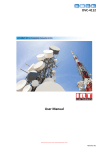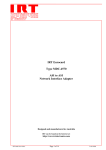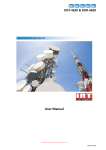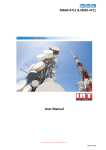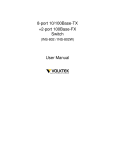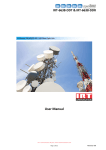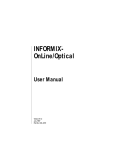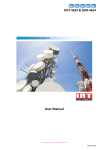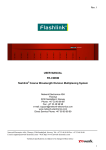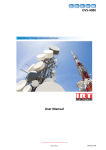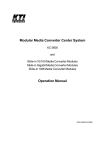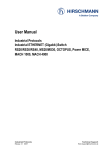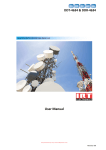Download EOT-4581 User Manual (Revision 00)
Transcript
EOT-4581 Ethernet to Optical Fibre Transceiver User Manual IRT Electronics Pty Ltd | www.irtelectronics.com Page 1 of 14 Revision 00 EOT-4581 Ethernet to Optical Fibre Transceiver Revision History: Revision 00 Date 27/11/2014 By AL Change Description Original Issue. Applicable to: Firmware ≥ Revision 1.0 IRT Electronics Pty Ltd | www.irtelectronics.com Page 2 of 14 Revision 00 EOT-4581 USER MANUAL Table of Contents: Section Page Revision History Operational Safety General Description Technical Specifications Configuration Installation Ethernet Connection Fibre Connections Alarm Connections Front & Rear Panel Connector Diagrams Operation Interfacing to a Gig-E Switch Front Panel LED Indicators SNMP – What Is It? EOT-4581 SNMP Functions Maintenance & Storage Warranty & Service 2 4 5 6 7 7 7 7 7 8 9 10 10 11 13 14 14 This instruction book applies to units fitted with firmware ≥ Revision 1.0. IRT Electronics Pty Ltd | www.irtelectronics.com Page 3 of 14 Revision 00 EOT-4581 OPERATIONAL SAFETY WARNING Operation of electronic equipment involves the use of voltages and currents that may be dangerous to human life. Note that under certain conditions dangerous potentials may exist in some circuits when power controls are in the OFF position. Maintenance personnel should observe all safety regulations. Do not make any adjustments inside equipment with power ON unless proper precautions are observed. All internal adjustments should only be made by suitably qualified personnel. All operational adjustments are available externally without the need for removing covers or use of extender cards. Optical Safety The light emitted from the LASER diode used in this system is invisible and may be harmful to the human eye. Avoid looking directly into the fibre optic cable or connectors or into the collimated beam along their axis when the device is in operation. Operating the LASER diode outside of its maximum ratings may cause device failure or a safety hazard. DANGER Invisible LASER radiationAvoid direct exposure to beam Peak power Wavelength 2 mW 1270–1610nm Class 1 LASER Product IRT Electronics Pty Ltd | www.irtelectronics.com Page 4 of 14 Revision 00 EOT-4581 GENERAL DESCRIPTION BLOCK DIAGRAM EOT-4581 SIGNAL PATH EOT-4581 EOT-4581 10/100/1000 Bi-directional Ethernet Port 1 Rx Fibre I/P Tx Fibre O/P Ethernet I/O Fibre Link 9-30dB1,3 path loss Ethernet I/O Tx Fibre O/P Rx Fibre I/P SNMP 10/100/1000 Bi-directional Ethernet Port 2 SNMP rd 3 Party Gig-E Switch with 1000 Base-X Optical Interface Multi Bi-directional Ethernet Ports The EOT-4581 transceiver module is designed principally for use as a 10/100/1000 Base-T Ethernet to fibre optic 1 transmission link, using 9/125μm single mode fibre, with optical paths losses up to 30dB . The EOT-4581 conforms to the IEEE 802.3i, 802.3y and 802.3ab standards for Ethernet over CAT-5 cable, and the IEEE 802.3z (1000 Base-X) standard for Gigabit Ethernet over optical fibre. The Ethernet port has automatic MDI/MDI-X detection, this detects whether the Ethernet interconnect cable is a straight through or cross over type and automatically switches itself to accommodate, and will automatically select the link speed of the connected network (10/100/1000 Mb/s). The EOT-4581 is also able to support Jumbo frames, which are Ethernet frames with more than 1500 bytes of payload data, up to a maximum frame size of 10,240 bytes. A fibre transceiver is incorporated on the one card allowing bi-directional communication over a pair of SC/PC single mode fibre optic cables. 1,2 Optionally a 1310/1550nm WDM optical combiner can be fitted to allow for combined use on a single fibre. As well as being able to be used as a pair for a point to point fibre link, the EOT-4581‘s fibre output is 1000 Base-X and can be directly interfaced into an Ethernet switch with an equivalent optical interface. The EOT-4581 is a Eurocard module designed to fit IRT’s 1RU frame or IRT’s 4000 series frames for use with IRT’s SNMP system and may be used alongside any other of IRT’s Eurocards. Standard features: • Suitable for 10/100/1000 Base-T Ethernet. • Standard RJ-45 CAT-5 Ethernet connection. • Supports Jumbo frames. • 1000 Base-X optical interface. • Path lengths up to 30dB optical path loss using 9/125μm single mode fibre. • Optional on-board WDM1, 2 optical combiner for use on a single common fibre. • SNMP software monitoring. NOTE: 1 2 3 With the WDM option fitted, optical path loss is reduced by approximately 2dB. With the WDM option fitted, when operating as a pair, one EOT-4581 must be fitted with a 1310nm transceiver and the other a 1550nm transceiver. An optical attenuator is required for optical path losses <9dB. IRT Electronics Pty Ltd | www.irtelectronics.com Page 5 of 14 Revision 00 EOT-4581 TECHNICAL SPECIFICATIONS Ethernet: Type Data Rate Maximum Frame Size Connector Optical: Type Data Rate 4, 5 Optical Path Loss Optical Fibre Optical Wavelength Standard IEEE 802.3i, 802.3y & 802.3ab 10/100/1000 Mb/s, automatic. 10,240 bytes. RJ-45. Optical Output Optical Input Standard 802.3z (1000 Base-X). 1000 Mb/s. 9 to 30 dB. Designed for use with 9/125μm single mode fibre. 1310nm (standard); 1470nm, 1490nm, 1510nm, 1530nm, 1550nm, 1570nm, 1590nm or 1610nm available. Dual SC/PC (standard); Single SC/PC (WDM version). 0 dBm +4.5/-0 dB DFB laser. APD detector (standard), -9 to -30 dBm input level. Power Requirements: Voltage Power consumption 28 Vac CT (14-0-14) or ± 16 Vdc. < 2.5 VA. Optical Connectors Other: Temperature range Mechanical Finish Front panel Rear assembly Dimensions Ordering: EOT-4581 EOT-4581/xxxx 0 - 50° C ambient. For mounting in IRT 19" rack chassis with input, output and power connections on the rear panel. Grey, black lettering & red IRT logo. Detachable silk-screened PCB with direct mount connectors to Eurocard and external signals. 6 HP x 3 U x 220 mm IRT Eurocard. EOT-4581/1310/WDM EOT-4581/1550/WDM Standard EOT-4581 fitted with 1310nm laser. EOT-4581 fitted with laser other than 1310nm where xxxx = wavelength required (e.g. EOT-4581/1550 is fitted with a 1550nm laser). EOT-4581 fitted with WDM and 1310nm laser. EOT-4581 fitted with WDM and 1550nm laser. NOTE: 4 5 Optical attenuator required for EOT-4581 when optical path loss is less than 9dB. Optical path loss reduced by approximately 2dB when WDM option fitted. Due to our policy of continuing development, these specifications are subject to change without notice. IRT Electronics Pty Ltd | www.irtelectronics.com Page 6 of 14 Revision 00 EOT-4581 CONFIGURATION There are no configuration settings for the EOT-4581. INSTALLATION Pre-installation: Handling: This equipment may contain or be connected to static sensitive devices and proper static free handling precautions should be observed. Where individual circuit cards are stored, they should be placed in antistatic bags. Proper antistatic procedures should be followed when inserting or removing cards from these bags. Installation in frame or chassis: See details in separate manual for selected frame type. Ethernet Connection: The Ethernet port is accessible via the rear assembly and is fitted with a standard RJ-45 connector suitable for either crossover or non-crossover standard CAT5 Ethernet cables. This port connects directly to an Ethernet link, or via an Ethernet router or Ethernet switch and will automatically set itself to match the input data rate of 10Mb/s, 100Mb/s or 1000Mb/s. Green LED’s on the Ethernet connector illuminate when an optical link and an Ethernet link have been established. Optical Link LED Ethernet Link LED Fibre Connections: Optical connections are made via SC/PC (standard) terminated single mode fibre directly to the rear of the main card accessible via the rear assembly. Care should be taken when removing the card either by disconnecting the optical cables first or allowing enough slack for the optical cable to pass through the frame. The top optical connector is the optical transmitter output and the lower optical connector is the optical receiver input. If the card has been fitted with the WDM option, both optical transmit and receive signals are combined on a single SC/PC fibre. When operating the WDM option, one unit must be fitted with a 1310nm transceiver and the other must be fitted with a 1550nm transceiver. For path lengths <9dB for an APD type of transceiver, or <3dB for a PIN type of transceiver, an optical attenuator (supplied) must be used in the path to avoid overloading the optical detector else damage to the detector itself may result. Alarm Connections: The external alarm contact connections are made to the 4 pin phoenix style connector on the rear assembly. On an alarm condition relay contacts go open circuit, that is switch open with respect to ground. The connections being: 1 2 3 4 GND. GND. Optical Alarm. Ethernet Alarm. A Optical alarm is designated as a laser or optical input fail alarm. A Ethernet alarm is designated as an Ethernet input is missing. IRT Electronics Pty Ltd | www.irtelectronics.com Page 7 of 14 Revision 00 EOT-4581 Front & Rear Panel Connector Diagrams: Alarm O/P Alarm O/P Tx O/P Tx/Rx Rx I/P Standard WDM Option IRT Electronics Pty Ltd | www.irtelectronics.com Page 8 of 14 Revision 00 EOT-4581 OPERATION The EOT-4581 is designed to operate as a pair with a second EOT-4581. Each unit does the Ethernet to Optical conversion and the reciprocal Optical to Ethernet conversion. The EOT-4581 Ethernet port will automatically configure itself to match the Ethernet link, whether it be 10/100/1000 Mb/s rate. It also automatically sets itself up for MDI or MDI-X operation, so there are no setup options required for connecting to an Ethernet link allowing the use of straight through or crossover cables to be used. The laser output connector (upper connector) connects at one end of a single mode fibre fitted with the corresponding fibre connector (SC/PC - standard). The other end of the fibre connects to another EOT-4581 into the receiver input connector (lower connector). Likewise the reverse is true with a second fibre to supply the return path. Application Diagram: Optic Fibre 9-30dB Path Loss EOT-4581 Bi-directional Ethernet Port 1 EOT-4581 Tx O/P Tx O/P Rx I/P Optic Fibre 9-30dB Path Loss Rx I/P Bi-directional Ethernet Port 2 NOTE: Optical attenuator required if path loss < 9dB for APD detector or < 3dB for PIN detector. Alternatively it is possible to run bi-directionally on a single fibre if the two EOT-4581’s are fitted with the optional WDM optical Mux and each have a different wavelength laser fitted, namely 1310nm and 1550nm Alternative the standard version cards can be run through an external CWDM optical Mux. Standard optical connector for the WDM version is SC/PC. Application Diagram: Bi-directional Ethernet Port 1 EOT-4581 /1310/WDM (1310nm) Optic Fibre 7-28dB Path Loss Fibre I/O EOT-4581 /1550/WDM (1550nm) Fibre I/O Bi-directional Ethernet Port 2 NOTE: Optical attenuator required if path loss < 7dB for APD detector or < 1dB for PIN detector. For path lengths <9dB optical loss when using an APD detector, or <3dB optical loss when using a PIN detector, an optical attenuator is required. The length of fibre that this corresponds to depends on the fibre loss characteristics at the relevant wavelength of the laser module chosen. For example, if the fibre loss characteristic of the chosen fibre is 0.2dB per kilometre at 1550 nm, say, then the maximum distance that can be run is 150 km (30dB/0.2dBkm), although connector losses, such as through patch lead connectors etc., should also be taken into consideration when calculating maximum distances. Actual attenuation versus wavelength characteristics depends upon optic fibre manufacturer’s own specifications. Also a few dB headroom is recommended to allow for the effects of laser aging over time. IRT Electronics Pty Ltd | www.irtelectronics.com Page 9 of 14 Revision 00 EOT-4581 Interfacing to a Gig-E Switch: The optical output conforms to the IEEE 802.3z (1000 Base-X) standard. This allows the EOT-4581 card to directly rd interface to a 3 party Gig-E Switch that has an optical I/O port conforming to the same standard. As such, only one EOT-4581 card is required. The advantage of this is an Ethernet connection can be added to an existing system that is too far away than can be connected by CAT5 or CAT 6 twisted pair cable, such as between two buildings or across town. Application Diagram: Optic Fibre Path Loss dependent upon Gig-E Switch specs. EOT-4581 Bi-directional Ethernet Port Tx O/P Rx I/P rd 3 Party Gig-E Switch with 1000 Base-X Optical Interface Multi Bi-directional Ethernet Ports NOTE: Optical attenuator required if path loss < 9dB for APD detector, or < 3dB for PIN detector, for EOT-4581, and also dependent upon Gig-E Switch specs. Front Panel LED Indicators: The OPT LED will illuminate green when an optical signal has been received. If the optical input level is approaching or has exceeded its threshold limit, this LED will flash green to indicate an Optical Low state. The Optical Low trigger point can vary between the plug-in receivers, so if operating at signal paths close to the recommended maximum specified threshold confirmation of the Quality of Service should be checked. No illumination indicates that there is no optical link established, either there is no input present or the input signal is far below its recommended operating range. The left LED on the rear assembly’s Ethernet connector will also illuminate when an optical signal has been received, but this LED will not flash on an Optical Low state. OPT LINK 10 100 1000 EOT-4581 The LINK LED down indicates the presence of an Ethernet signal by illuminating green. If there is no Ethernet signal present, this LED will not illuminate. The right LED on the rear assembly’s Ethernet connector will also illuminate green when an Ethernet connection has been detected, but this LED does not indicate what Ethernet rate has been connected. The 10, 100 and 1000 LEDs will illuminate green for a connected 10/100/1000 Mb/s Ethernet signal respectively. In the shown example, a 100Mb/s (FAST) Ethernet signal has been connected. IRT Electronics Pty Ltd | www.irtelectronics.com Page 10 of 14 Revision 00 EOT-4581 SNMP What Is It? SNMP stands for Simple Network Management Protocol. It is an application layer protocol for managing IP (Internet Protocol) based systems. SNMP enables system administrators to manage system performance, and to find and solve system problems. SNMP runs over UDP (User Datagram Protocol), which in turn runs over IP. Three types of SNMP exist: SNMP version 1 (SNMPv1), SNMP version 2 (SNMPv2) and SNMP version 3 (SNMPv3). It is not the intention here to discuss the differences between various versions, only to bring attention to the fact that IRT Electronics modules, fitted with SNMP capability, use SNMPv1. An SNMP managed network consists of three key components: Network Management Systems (NMS), agents, and managed devices. An NMS is the console through which the network administrator performs network management functions, such as monitoring status (e.g. alarm states) and remote controlling, of a set of managed devices. One or more NMS’s must exist on any managed network. Generally the NMS is a computer running third party SNMP control software. There are a number of third party SNMP software applications currently available on the market. An NMS polls, or communicates with, an agent. An agent is a network management software module that resides in a managed device. An agent has local knowledge of management information and translates that information into a form compatible with SNMP. The agent, therefore, acts as an interface between the NMS and the managed devices. The NMS sends a request message, and control commands for the managed devices, to the agent, which in turn sends a response message, containing information about the managed devices, back to the NMS. A managed device contains an SNMP agent and resides on a managed network. Managed devices collect and store management information and make this information available to NMS’s using SNMP. Managed device agent variables are organised in a tree structure known as a Management Information Base (MIB). Within the MIB are parameters pertaining to the managed device. An Object Identifier (OID) number within the MIB defines the managed device type. This is a unique number specific to the model of managed device. Other information relating to the device is also stored, information such as alarm states, controllable settings, etc. The MIB tree is organised in such a way that there will be no two MIB files with conflicting placements. Normally an NMS polls an agent for information relating to the MIB in a managed device to be sent back to the NMS. When certain conditions are met within the MIB, such as major alarm conditions, for example, the agent automatically sends what is known as a trap to the NMS without any prompting from the NMS. This allows automatic notification of a predetermined event. SNMP Block Diagram NMS IP Network NMS SNMP Agent Protocol Engine MIB SNMP Agent SNMP Agent Protocol Engine MIB SNMP Agent SNMP Agent Protocol Engine MIB SNMP Agent IRT Electronics Pty Ltd | www.irtelectronics.com Page 11 of 14 Revision 00 EOT-4581 SNMP with IRT Products: IRT Electronics currently employs SNMPv1 with its SNMP capable frames. The frame acts as an agent when fitted with a CDM-xxxx module. This module has its own designated slot next to the power supply so as to not affect the number of modules that the frame will take. Communication between the NMS, the frame and its loaded modules are via this CDM-xxxx module. Note that the NMS software is third party and not supplied by IRT Electronics. Ethernet connection for SNMP operation is via an RJ45 connector on the rear of the frame, below the mains inlet. Ethernet rate runs at either 10 baseT or 100 baseT. Frame parameters, such as Name, Address and Location, are set via an RS232 interface, a D9 connector on the rear of the frame below the mains inlet. A software terminal emulator, such as Tera Term or HyperTerminal, is used for setting and reading the parameters of the frame. IRT modules that are SNMP compatible may need an optional plug-in SNMP module with a program relevant to the module that it is plugged into. Depending on the module, besides the module identification, parameters such as alarm states, inputs and controls etc. are communicated to the CDM-xxxx agent via a data bus on the rear of the frame. Thus the CDM-xxxx collects information on what is loaded within the frame, what positions they occupy, and their current status for communication to the NMS when the NMS sends a request for information. In the event of a major alarm from any of the SNMP compatible modules, or power supplies, a trap is automatically sent by the CDM-xxxx agent to the NMS without any prompting by the NMS. This alerts the operator to any fault conditions that may exist that need immediate attention. 110/240 V 50/60 Hz 0.7 A (max.) FRU-4000 FRAME FUSES 220/240 Vac 500 mA S.B. 110/120 Vac 1A S.B. RS232 Alarm Ethernet + 48Vdc AS3260 approval no.: CS6346N Ass. no.: 804692 IRT SNMP Connections NMS Ethernet Cable IP Network IRT modules fitted with SMU-4000 CDM-xxxx PSU’s IRT SNMP Frame Ethernet Cable IRT modules fitted with SMU-4000 CDM-xxxx PSU’s IRT SNMP Frame Ethernet Cable IRT SNMP Setup IRT Electronics Pty Ltd | www.irtelectronics.com Page 12 of 14 Revision 00 EOT-4581 EOT-4581 SNMP Functions: The following SNMP functions are capable of being controlled and monitored by an NMS: sysDescr - A description of the unit: EOT-4581 Ethernet to Optical Transceiver sysObjectID - Object identifier: irtEOT4581 sysUpTime - A indication of how long the unit has been running since its last power on or reset in Days, Hours, Minutes and Seconds. sysName - A 16 character writable system name. Default set name: EOT-4581 sfpType - An indication of the detected plug-in SFP module: (1) transceiver: Transceiver module detected. Should indicate this. (2) notDetected: No plug-in SFP detected. (3) unknownSFP: Unable to determine the type of plug-in SFP module. sfpReceiverType - An indication of the transceiver’s detector type: (1) unknown: Unable to determine the type of detector. (2) apd: APD detector fitted. (3) pin: PIN detector fitted. sfpwavelength - An indication of the transceiver’s wavelength. opticalLink - An indication of the transceiver’s optical input: (1) connected: Good optical level received. (2) disconnected: No optical input detected – either not connected or path length is too great. (3) lowPower: Optical detector of receiver is reporting that the optical input signal is approaching its minimum, or has exceeded its, allowable signal strength. NOTE: Detectors can vary in their reporting of optical low state. It is recommended to confirm that the received signal is error free if a lowPower alarm has been raised. ethernetLink - An indication of the status of the Ethernet link: (1) connected: Ethernet signal connected. (2) disconnected: No Ethernet signal is detected. ethernetRate - An indication of the data rate of the Ethernet link: (1) 10Mbs: 10Mb/s Ethernet data rate connected. (2) 100Mbs: 100Mb/s (FAST) Ethernet data rate connected. (3) 1Gbs: 1000Mb/s (Gig-E) Ethernet data rate connected. (4) unknown: Unknown data rate or no connection. softwarever - An indication of the software revision of this card. reset - Unit reset control: (0) normal: when queried reset control returns a ‘normal’ message. (1) reset: Setting a 1 causes a reset of the card. generalAlarmTrap - An indication and control of Trap enable/disable function: (1) enable: Enable general alarm Trap. (2) disable: Disable general alarm Trap. IRT Electronics Pty Ltd | www.irtelectronics.com Page 13 of 14 Revision 00 EOT-4581 MAINTENANCE & STORAGE Maintenance: No regular maintenance is required. Care however should be taken to ensure that all connectors are kept clean and free from contamination of any kind. This is especially important in fibre optic equipment where cleanliness of optical connections is critical to performance. Storage: If the equipment is not to be used for an extended period, it is recommended the whole unit be placed in a sealed plastic bag to prevent dust contamination. In areas of high humidity a suitably sized bag of silica gel should be included to deter corrosion. Where individual circuit cards are stored, they should be placed in antistatic bags. Proper antistatic procedures should be followed when inserting or removing cards from these bags. WARRANTY & SERVICE Equipment is covered by a limited warranty period of three years from date of first delivery unless contrary conditions apply under a particular contract of supply. For situations when “No Fault Found” for repairs, a minimum charge of 1 hour’s labour, at IRT’s current labour charge rate, will apply, whether the equipment is within the warranty period or not. Equipment warranty is limited to faults attributable to defects in original design or manufacture. Warranty on components shall be extended by IRT only to the extent obtainable from the component supplier. Equipment return: Before arranging service, ensure that the fault is in the unit to be serviced and not in associated equipment. If possible, confirm this by substitution. Before returning equipment contact should be made with IRT or your local agent to determine whether the equipment can be serviced in the field or should be returned for repair. The equipment should be properly packed for return observing antistatic procedures. The following information should accompany the unit to be returned: 1. 2. 3. 4. 5. 6. 7. A fault report should be included indicating the nature of the fault The operating conditions under which the fault initially occurred. Any additional information, which may be of assistance in fault location and remedy. A contact name and telephone and fax numbers. Details of payment method for items not covered by warranty. Full return address. For situations when “No Fault Found” for repairs, a minimum charge of 1 hour’s labour will apply, whether the equipment is within the warranty period or not. Contact IRT for current hourly rate. Please note that all freight charges are the responsibility of the customer. The equipment should be returned to the agent who originally supplied the equipment or, where this is not possible, to IRT directly. Details of IRT’s direct address can be found at IRT Electronics’ website. Web address: www.irtelectronics.com Email: [email protected] IRT Electronics Pty Ltd | www.irtelectronics.com Page 14 of 14 Revision 00














